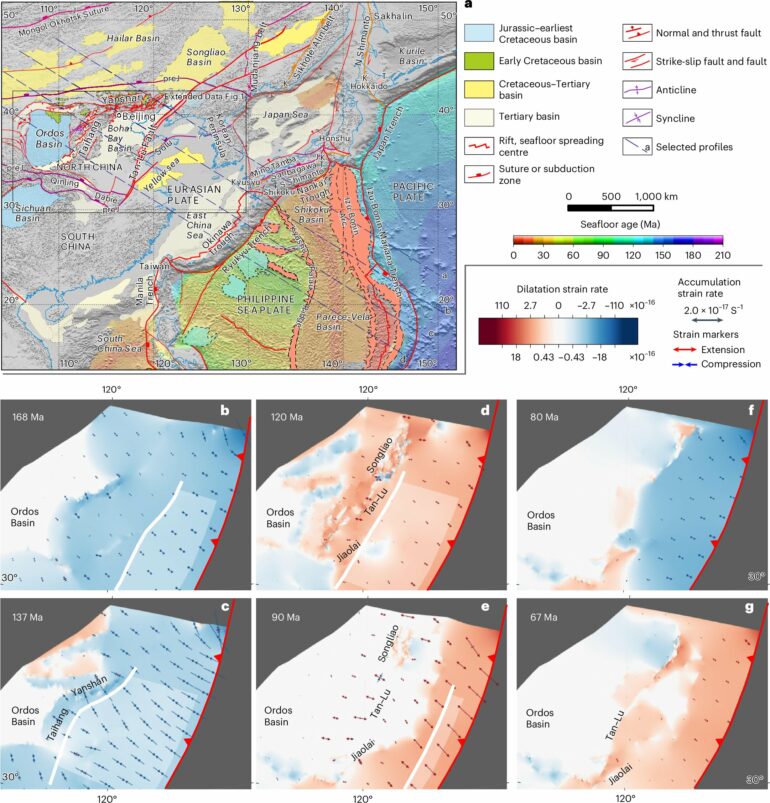Cratons are fascinating yet enigmatic geological formations. Known to be relatively stable portions of the Earth’s continental crust, cratons have remained largely unchanged for billions of years. Although cratons have survived many geological events, some are undergoing decratonization—a process characterized by their deformation and eventual destruction.
For example, the North China Craton (NCC), an ancient continental crust block, is known to have begun extensive decratonization during the Mesozoic era, largely due to tectonic and geochemical modifications and destabilization of its base (or “keel”). However, explaining the mechanisms behind these complex geological transformations has proven difficult with existing techniques and current understanding.
In a recent study published in Nature Geoscience, a research team led by Professor Shaofeng Liu from China University of Geosciences (Beijing) successfully addressed this knowledge gap by developing a computational model supported by extensive geological, geophysical, and empirical geochemical data that explains the puzzling deformation of the NCC.
Specifically, the developed model focuses on the subduction of the Izanagi plate beneath the Eurasian plate, where the NCC is located, as the reason underlying the observed decratonization.
The researchers compared several possible subducted plate geometries using earthquake seismicity and basin stratigraphy evidence to narrow down potential reconstructions. Finally, using their geodynamic mantle-flow model, they simulated the full extent of the subduction process and validated the predictions empirically.
Their analysis explains the decratonization of the NCC in three phases. First, the Izanagi plate underwent initial subduction and slid beneath the Eurasian plate. However, instead of progressing downward, the Izanagi plate flattened and started moving parallel to the Eurasian plate, in a process called flat-slab subduction. Fluids from the subducted plate altered the NCC’s keel above, initiating its destruction. In addition, squeezing forces caused other deformations, such as thrusting, craton thickening, and surface uplift.
Interestingly, there was then a rollback process, as a result of which the subducted plate steepened again and progressed deeper below the Eurasian plate, reaching the upper-lower mantle interface and undergoing horizontal subduction into the mantle transition zone. This rollback caused extensional deformation, resulting in thinning of the lithosphere and the formation of rift basins with surface topographic lowing on the craton.
Additionally, a large region of upper mantle material, known as a “large mantle wedge,” developed between the advancing slab and the craton, leading to convection that can induce intense metasomatism and partial melting along with heating and erosion at the base of the sub-craton, as well as magmatism.
Prof. Liu says, “We successfully developed a new mantle-flow model incorporating flat-slab and rollback subduction, which aligns with surface geological evolution and the present-day mantle slab structure.
“Interestingly, our validated model can effectively describe the space–time dynamics and topographic response of mantle slab subduction over time.”
Given that cratons contain mineral and rare-earth element deposits with immense value for technological applications, understanding the life cycle of cratons is important from both an academic and a practical standpoint. Building on these insights, further inquiries into the geological history of our planet will hopefully lead us to a deeper understanding of geological processes like decratonization, revealing paths towards a more sustainable future.
More information:
Shaofeng Liu et al, Craton deformation from flat-slab subduction and rollback, Nature Geoscience (2024). DOI: 10.1038/s41561-024-01513-2
Provided by
China University of Geosciences
Citation:
Geodynamic mantle-flow model explains deformation of continental crust block in North China (2024, November 3)



